Related Research Articles

John Alden was a crew member on the historic 1620 voyage of the Mayflower which brought the English settlers commonly known as Pilgrims to Plymouth Colony in Massachusetts. He was hired in Southampton, England as the ship's cooper, responsible for maintaining the ship's barrels. He was a member of the ship's crew and not a settler, yet he decided to remain in Plymouth Colony when the Mayflower returned to England. He was a signatory to the Mayflower Compact.

Myles Standish was an English military officer and colonist. He was hired as military adviser for Plymouth Colony in present-day Massachusetts, United States by the Pilgrims. Standish accompanied the Pilgrims on the ship Mayflower and played a leading role in the administration and defense of Plymouth Colony from its foundation in 1620. On February 17, 1621, the Plymouth Colony militia elected him as its first commander and continued to re-elect him to that position for the remainder of his life. Standish served at various times as an agent of Plymouth Colony on a return trip to England, as assistant governor of the colony, and as its treasurer.
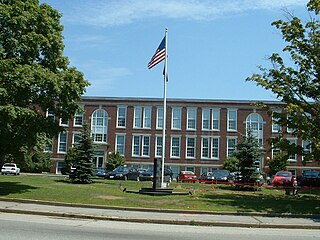
Dartmouth is a coastal town in Bristol County, Massachusetts, United States. Old Dartmouth was the first area of Southeastern Massachusetts to be settled by Europeans, primarily English. Dartmouth is part of New England's farm coast, which consists of a chain of historic coastal villages, vineyards, and farms. June 8, 2014, marked the 350th year of Dartmouth's incorporation as a town. It is also part of the Massachusetts South Coast. The local weekly newspapers are The Dartmouth/Westport Chronicle and Dartmouth Week. The Portuguese municipality of Lagoa is twinned with the town; along with several other Massachusetts and Rhode Island towns and cities around Bristol County.

Plymouth Colony was the first permanent English colony in New England from 1620 and the third permanent English colony in America, after Newfoundland and the Jamestown Colony. It was settled by the passengers on the Mayflower at a location that had previously been surveyed and named by Captain John Smith. The settlement served as the capital of the colony and developed as the town of Plymouth, Massachusetts. At its height, Plymouth Colony occupied most of the southeastern portion of Massachusetts. Many of the people and events surrounding Plymouth Colony have become part of American folklore, including the American tradition of Thanksgiving and the monument of Plymouth Rock.
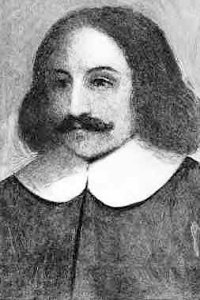
William Bradford was an English Puritan Separatist originally from the West Riding of Yorkshire in Northern England. He moved to Leiden in Holland in order to escape persecution from King James I of England, and then emigrated to the Plymouth Colony on the Mayflower in 1620. He was a signatory to the Mayflower Compact and went on to serve as Governor of the Plymouth Colony intermittently for about 30 years between 1621 and 1657. He served as a commissioner of the United Colonies of New England on multiple occasions and served twice as president. His journal Of Plymouth Plantation covered the years from 1620 to 1646 in Plymouth.

Duxbury is a historic seaside town in Plymouth County, Massachusetts, United States. A suburb located on the South Shore approximately 35 miles (56 km) to the southeast of Boston, the population was 16,090 at the 2020 census.

Plymouth is a town and county seat of Plymouth County, Massachusetts, United States. Located in Greater Boston, the town holds a place of great prominence in American history, folklore, and culture, and is known as "America's Hometown". Plymouth was the site of the colony founded in 1620 by the Mayflower Pilgrims, where New England was first established. It is the oldest municipality in New England and one of the oldest in the United States. The town has served as the location of several prominent events, one of the more notable being the First Thanksgiving feast. Plymouth served as the capital of Plymouth Colony from its founding in 1620 until the colony's merger with the Massachusetts Bay Colony in 1691. The English explorer John Smith named the area Plymouth and the region 'New England' during his voyage of 1614. It was a later coincidence that, after an aborted attempt to make the 1620 trans-Atlantic crossing from Southampton, the Mayflower finally set sail for America from Plymouth, England.

Plymouth is a rural town in Grafton County, New Hampshire, United States, in the White Mountains Region. It has a unique role as the economic, medical, commercial, and cultural center for the predominantly rural Plymouth, NH Labor Market Area. Plymouth is located at the confluence of the Pemigewasset and Baker rivers and sits at the foot of the White Mountains. The town's population was 6,682 at the 2020 census. It is home to Plymouth State University, Speare Memorial Hospital, and Plymouth Regional High School.
A haunted house, spook house or ghost house in ghostlore is a house or other building often perceived as being inhabited by disembodied spirits of the deceased who may have been former residents or were otherwise connected with the property. Parapsychologists often attribute haunting to the spirits of the dead who have suffered from violent or tragic events in the building's past such as murder, accidental death, or suicide.
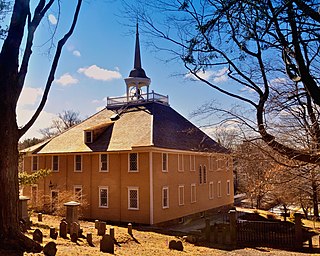
Hingham is a town in metropolitan Greater Boston on the South Shore of the U.S. state of Massachusetts in northern Plymouth County. At the 2020 census, the population was 24,284. Hingham is known for its colonial history and location on Boston Harbor. The town was named after Hingham, Norfolk, England, and was first settled by English colonists in 1633.

Plymouth Rock is the historical site of disembarkation of the Mayflower Pilgrims who founded Plymouth Colony in December 1620.

Plimoth Patuxet is a complex of living history museums in Plymouth, Massachusetts founded in 1947, formerly Plimoth Plantation. It replicates the original settlement of the Plymouth Colony established in the 17th century by the English colonists who became known as the Pilgrims. They were among the first people who emigrated to America to seek religious separation from the Church of England. It is a not-for-profit museum supported by administrations, contributions, grants, and volunteers. The recreations are based upon a wide variety of first-hand and second-hand records, accounts, articles, and period paintings and artifacts, and the museum conducts ongoing research and scholarship, including historical archaeological excavation and curation locally and abroad.

Degory Priest was a member of the Leiden contingent on the historic 1620 voyage of the ship Mayflower. He was a hat maker from London who married Sarah, sister of Pilgrim Isaac Allerton in Leiden. He was a signatory to the Mayflower Compact in November 1620 and died less than two months later.

A haunted attraction is a form of live entertainment that simulates visiting haunted locations or experiencing horror scenarios. They usually feature fearsome sets and characters, especially demons, ghosts, skeletons, zombies, monsters, possessed people, witches, serial killers, and slashers. Humorous characters may also be included.
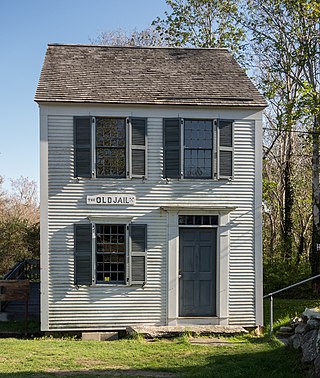
Barnstable's Old Gaol is a historic colonial jail in Barnstable, Massachusetts. Built c.1690, it is the oldest wooden jail in the United States of America.
The America's Hometown Thanksgiving Parade is an annual parade held in Plymouth, Massachusetts. The parade, which began in 1996, is traditionally held the weekend before Thanksgiving and draws its name from the fact that Plymouth Colony was the landing point of the Pilgrims involved in the traditional "First Thanksgiving" in the early 1620s. Unlike most Thanksgiving parades, which include giant balloons of popular characters, the America's Hometown parade has a strict theme. Each element in the parade is based on the history of the United States and arranged in chronological order, with five divisions separated by century: the colonial period of the 17th century, the Revolutionary period of the 18th century, the Civil War and pioneer periods of the 19th century, military and automotive showcases from the 20th and 21st centuries, and the closing division, the last of which includes the traditional Santa Claus float. The parade is part of the broader America's Hometown Thanksgiving Celebration, which includes a number of ceremonies, including a Turkey Trot, concerts and a street fair.
Paul Spooner was a Vermont political figure who served as lieutenant governor.

The Aptucxet Trading Post Museum is a small open-air historical museum in Bourne, Massachusetts. The main attraction is a replica of the 17th-century Aptucxet Trading Post which was built by the Pilgrims of Plymouth Colony in order to trade with the Wampanoag Indians and the Dutch. The museum also features a replica of a 19th-century saltworks, the relocated 19th-century Gray Gables Railroad Station, and a wooden smock windmill. The property was listed on the National Register of Historic Places in 2021.
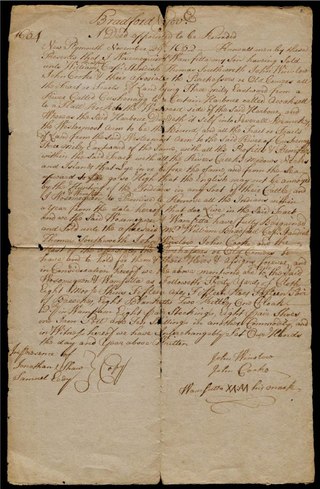
Old Dartmouth was the first area of Southeastern Massachusetts settled by Europeans. It was purchased on behalf of the Plymouth Colony in 1652 from the indigenous Wampanoag people. The lands included all of modern-day Dartmouth, New Bedford, Westport, Fairhaven, and Acushnet in current day Massachusetts, as well as parts of modern Tiverton and Little Compton In Rhode Island, an area of around 145,000 individuals in the modern area.
References
- ↑ Photograph of tour train America's Hometown Express"
- ↑ A Guide to Haunted New England: Tales from Mount Washington to the Newport Cliffs Thomas D'Agostino; The History Press, 2009; page 70